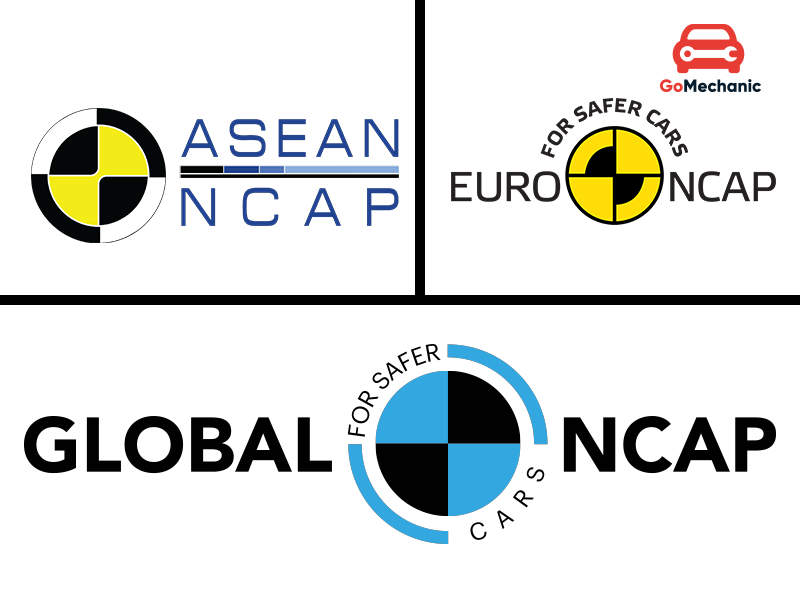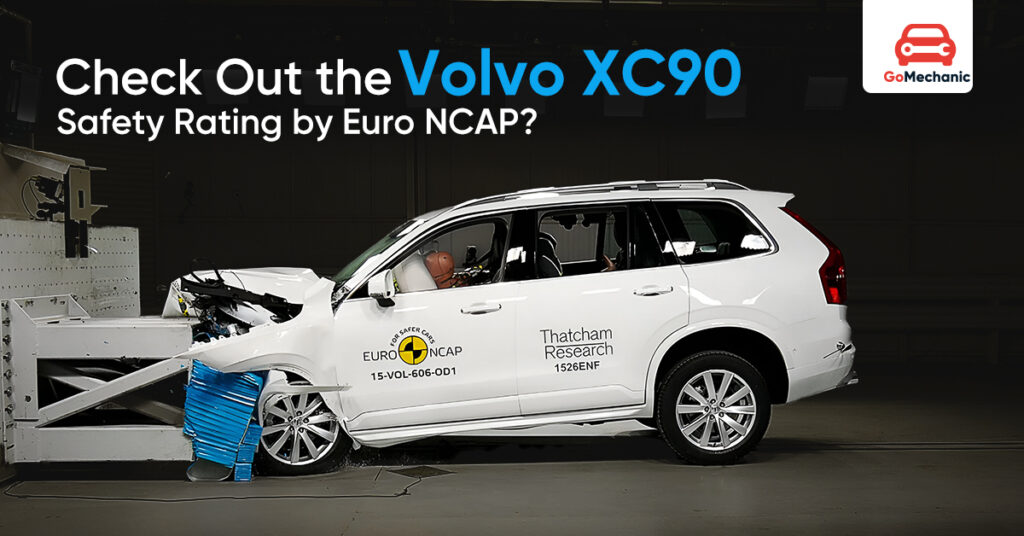When choosing a car, most people look at design, features, performance, and price, but in reality, safety should always come first. A vehicle that can provide you and your family adequate safety is a must, and to ensure that safety is provided by the car, various organisations test your car’s ability to protect you in case of an accident and rate them accordingly. In this blog, we are going to educate you on the Volvo XC90 safety rating, determined by these various organisations and how well it can protect you.
Why the Volvo XC90 Safety Ratings Matter?
If you are unfamiliar with Safety Rating, worry not, we will make you understand it in simple words. As the name suggests safety rating determines how safe a car is and its ability to protect passengers inside. Wondering on what basis these ratings are determined? We’re glad you asked; these ratings are determined by organisations like Global NCAP, Euro NCAP. They evaluate cars on the basis of crash tests conducted by them. Let’s learn about these tests:
First and foremost is Adult Occupant Protection, which tests the car’s ability to protect its adult passengers and their different body parts. Second on the list of these tests is Child Occupant Protection, this test determines the car’s ability to safeguard the children present inside it. Global NCAP thoroughly examines various safety features that are installed inside the car to protect the children. Lastly, on the list of tests is Safety features, it is checked to determine if the vehicle has safety systems such as ESC, ABS, and others that are required to prevent any form of accident.
Here is why safety ratings matter:
- Higher-rated cars save lives. Data from multiple countries proves that occupants in 5-star rated vehicles have a much lower risk of fatal or serious injury during crashes.
- Safety ratings expose weak spots. Cars with poor structural integrity or outdated safety tech are highlighted through these tests.
- They push manufacturers to do better. When consumers start choosing cars based on safety ratings, brands are forced to improve their models.
What are NCAPs?

To assist a buyer in making better judgments, organisations called New Car Assessment Programs, or NCAPs, test cars under rigorous conditions and assess their safety. NCAPs perform real-world crash scenarios and assign safety ratings, usually shown as stars or points, based on how well an automobile protects its occupants. The following are some key NCAPs to be aware of:
1. Global NCAP
Focused mainly on emerging markets, Global NCAP tests cars on:
- Frontal offset crash at 64 km/h
- Adult and child occupant protection
- Side impact protection (for some models)
- ESC (Electronic Stability Control) verification
Cars are rated from 0 to 5 stars — higher stars mean better protection.
2. Euro NCAP
Operating across Europe, Euro NCAP has one of the most comprehensive safety programs. Tests include:
- Frontal offset crash
- Full-width frontal impact
- Side impact and pole impact tests
- Pedestrian impact protection
- Testing of active safety technologies like AEB, lane-keeping assist, and more
3. ASEAN NCAP
Covers Southeast Asia and focuses on:
- Frontal and side crash testing
- Motorcyclist protection systems
- Child occupant protection
For fun reads – The Legendary P1800: Volvo’s Highest Mileage Car 2025
Volvo XC90 NCAP Rating
Now, moving to the specific model, what is the Volvo XC90 safety rating? According to Euro NCAP, the Volvo XC90 achieved the highest possible 5-star rating during its latest assessment. Here are the detailed scores for the Volvo XC90 safety rating by Euro NCAP:
-
Adult Occupant Protection (97%)
| Test Type | Protection Level | |
|---|---|---|
|
Frontal Crash
|
Head & Neck | Good |
| Driver Chest | Good | |
| Passenger Chest | Good | |
| Knee Protection | Good | |
| Driver’s Tibias | Adequate | |
| Passenger’s Tibias | Adequate | |
|
Frontal Full Width |
Head | Good |
| Pelvis | Good | |
| Abdomen | Good | |
| Chest | Adequate | |
|
Lateral Impact |
Head | Good |
| Pelvis | Good | |
| Chest | Adequate | |
| Abdomen | Good |
-
Child Occupant Protection (87%)
- Crash test performance – 24.00 Pts
- Safety features – 7.0 Pts
- CRS installation check – 12.00 Pts
-
Vulnerable Road Users (72%)
-
Safety Assist Features (94%)
The Volvo XC90 safety rating makes it among the safest SUVs currently available worldwide. The strong body structure, advanced airbag systems, and cutting-edge driver assist technologies all contribute to its impressive results. Some of the key safety features that allow the Volvo XC90 safety rating to be high include:
- Pilot Assist
- City Safety System
- Run-off Road Protection
- 360-Degree Camera
- Blind Spot Information System (BLIS)
- Rear Collision Warning
- Cross Traffic Alert with Auto Brake
- Lane Keeping Aid
- Adaptive Cruise Control
- Driver Alert Control
Know more about Volvo cars – Volvo Cars in India: Safety, Luxury, and a New Era
Features and Specifications of the Volvo XC90
Not only is the Volvo XC90 safety rating high, but it also has strong specifications and premium features that make it a complete luxury SUV. Here’s an overview:
- Engine Options:
- 2.0L Petrol Mild-Hybrid
- Recharge Plug-in Hybrid (PHEV) available internationally
- Transmission:
8-speed automatic - Dimensions:
- Length: 4953 mm
- Width: 1958 mm
- Height: 1776 mm
- Wheelbase: 2984 mm
- Seating: Available as a 7-seater SUV.
- Interior Features:
- 9-inch Sensus touchscreen infotainment
- Premium Nappa leather seats
- 4-zone automatic climate control
- Air purifier system
- Panoramic sunroof
- Exterior Features:
- LED headlamps with Thor’s Hammer design
- Clean Scandinavian styling
- 19- to 21-inch alloy wheels (variant-dependent)
- Mileage:
Mild hybrid delivers around 12–14 km/l under mixed conditions.
Conclusion
A car is more than metal and glass. It’s a space we trust, a space where we let our guard down because we assume it’s built to guard us. The Volvo XC90 doesn’t sell safety like a flashy feature; it simply delivers it quietly, in every corner of its build. The Volvo XC90 safety ratings—97% for adult protection, 87% for children, 94% for safety assistance and 72% for vulnerable road users are the proof. They’re a result of decisions made not for style, not even for profit, but for something older and more essential: Responsibility and Safety.
FAQ’s
- Which is safer, Volvo or Audi?
If luxury is the main focus, Audi wins by a large margin, but if the question is safety, then Audi does not stand a chance against the Volvo.
- Which car brand is the safest?
Car brands such a Volkswagen Virtus, Skoda Slavia, Kushaq and Tata can be considered as the safest.
- What goes wrong in the XC90?
In practical usage, it has been found that the XC90’s diesel engine’s injector has been failing again & again, which is an expensive fix.
- Is the Volvo XC90 the world’s safest car?
Yes, the Volvo XC90, named as the Insurance Institute of Highway Safety’s 2023, can be considered the world’s safest car.
Want to know more about Safety Rating? Read these:
Volkswagen Tiguan Safety Rating: A Detailed Analysis
Kia EV6 Safety Rating: NCAP Test Results & Safety Features
BYD Seal: A Comprehensive Analysis of Its 5-Star Safety Ratings
A Detailed Analysis of Rolls-Royce Phantom Safety Rating, Features & Specification.
MG Gloster Safety Rating 2025: Crash Test Results, Features & Comparison
Hyundai Grand i10 Nios Safety Rating by Global NCAP
Volvo XC60 Safety Rating by Euro NCAP Along with Specification

